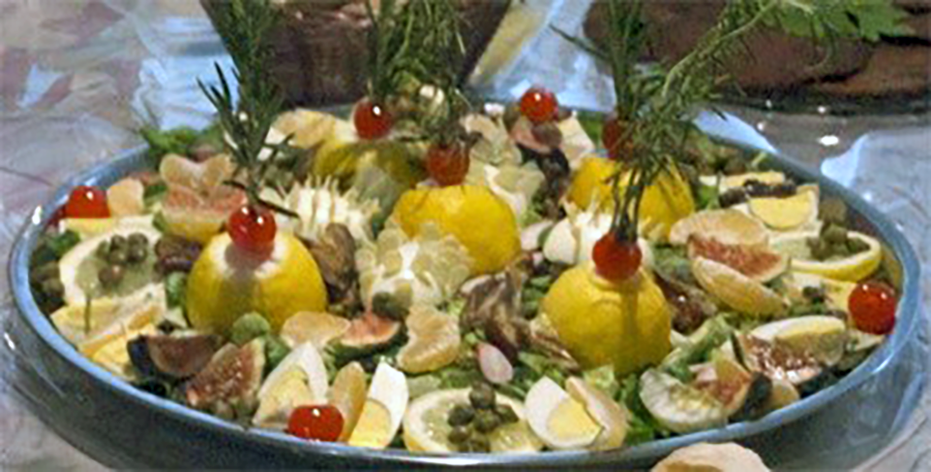FabulousFusionFood's Salad Recipes 3rd Page
 Salad types: green salad, mixed salad, pasta salad, fruit salad
Salad types: green salad, mixed salad, pasta salad, fruit salad
Welcome to FabulousFusionFood's Salad Recipes Page — A salad is a dish consisting of mixed ingredients, frequently vegetables. They are typically served chilled or at room temperature, though some can be served warm. Condiments and salad dressings, which exist in a variety of flavours, are used to make a salad.
Garden salads use a base of leafy greens such as lettuce, arugula or rocket, kale or spinach; they are common enough that the word salad alone often refers specifically to garden salads. Other types include bean salad, tuna salad, bread salad (such as fattoush, panzanella), vegetable salads without leafy greens (such as Greek salad, potato salad, coleslaw), rice-, pasta- and noodle-based salads, fruit salads and desserts.
The variety of salads is very large and they may be served at any point during a meal: starters – light, smaller-portion salads served as the first course of the meal; Side salads – to accompany the main course as a side dish; examples include potato salad and coleslaw; Main course salads – usually containing a portion of one or more high-protein foods, such as eggs, legumes, or cheese; Dessert salads – sweet salads containing fruit, gelatine, sweeteners or whipped cream.
Etymology: The word "salad" comes to English from the French salade of the same meaning, itself an abbreviated form of the earlier Vulgar Latin herba salata (salted herb), from the Latin salata (salted), from sal (salt). In English, the word first appears as "salad" or "sallet" in the 14th century. Salt is associated with salad because vegetables were seasoned with brine (a solution of salt in water) or salty oil-and-vinegar dressings during Roman times. The phrase "salad days", meaning a "time of youthful inexperience" (based on the notion of "green"), is first recorded by Shakespeare in 1606, while the use of salad bar, referring to a buffet-style serving of salad ingredients, first appeared in American English in 1937.
 A reconstructed Elizabethan grand sallet.
A reconstructed Elizabethan grand sallet.
A salad can be a composed salad (with the ingredients specifically arranged on the serving dish) or a tossed salad (with the ingredients placed in a bowl and mixed, often with salad dressing). An antipasto plate, the first dish of a formal Italian meal, is similar to a composed salad, and has vegetables, cheese, and meat.
Types of salad:
Green saladA green salad, or green leaf salad, another name for garden salad, is most often composed of leafy vegetables such as lettuce varieties, spinach, or rocket (arugula). If non-greens make up a large portion of the salad it may instead be called a vegetable salad. Common raw vegetables (in the culinary sense) used in a salad include cucumbers, peppers, tomatoes, onions, carrots, celery, radishes, mushrooms, avocado, olives, artichoke hearts, heart of palm, watercress, parsley, garden beets, and green beans. Nuts, berries, seeds, lentils, and flowers are less common components. Hard-boiled eggs, bacon, shrimp, and cheeses may be used as garnishes, but large amounts of animal-based foods would be more likely in a dinner salad.
Wedge salad
A wedge salad is a green salad made from a head of lettuce (often iceberg), halved or quartered, with other ingredients on top.
Bound salads
Bound salads are assembled with thick sauces such as mayonnaise. One portion of a bound salad will hold its shape when placed on a plate with a scoop. Examples of bound salad include tuna salad, chicken salad, egg salad, coleslaw, and potato salad. Some bound salads are used as sandwich fillings. Some pasta salads, e.g. macaroni salad, are bound salads.
Dinner salads
Main course salads (known as dinner salads[13] or as entrée salads in the United States) may contain small pieces of poultry, seafood, or steak. Caesar salad, chef salad, Cobb salad, Chinese chicken salad, Michigan salad, and Pittsburgh salad are dinner salads.
Fruit salads
Fruit salads are made of fruit (in the culinary sense), which may be fresh or canned. Examples include fruit cocktail
Dessert salads
Dessert salads rarely include leafy greens and are often sweet. Common variants are made with gelatin or whipped cream; e.g. jello salad, pistachio salad, and ambrosia. Other forms of dessert salads include regional dishes such as Midwestern America's ambrosia-like glorified rice and cookie salad, which contains crumbled cookies as an ingredient.
The alphabetical list of all the salad recipes on this site follows, (limited to 100 recipes per page). There are 226 recipes in total:
Page 3 of 3
Page 3 of 3